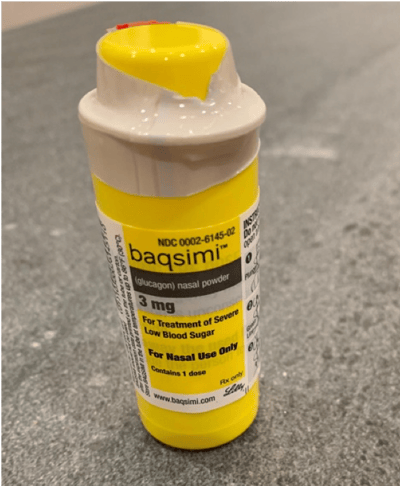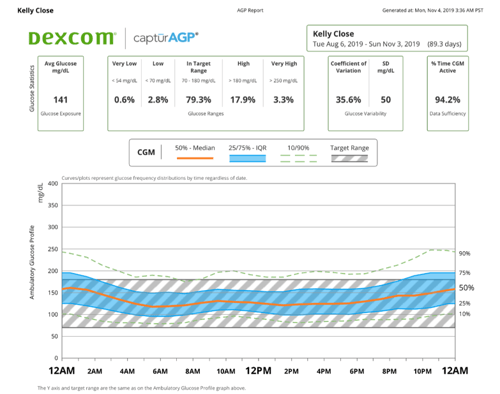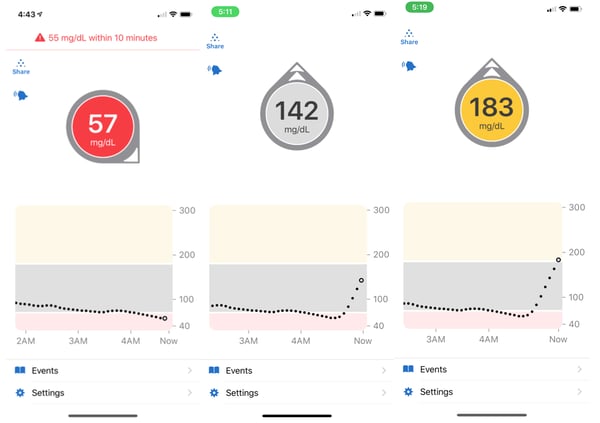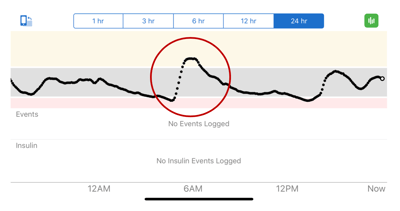Nasal Glucagon in Action – How I Used Baqsimi to Treat Severe Hypoglycemia
By Kelly Close
 By Kelly Close
By Kelly Close
A few weeks ago, Kelly experienced severe hypoglycemia (she left her RileyLink in her basement by accident!) – lucky for her, she had just picked up a new emergency glucagon from her pharmacy that Dr. Nancy Bohannon had recommended, along with Xeris’ new glucagon! In this interview, Kelly shares her experience with Baqsimi, and reflections on what the new treatment means for her health and well-being, and her family’s calm and happiness
New in the last several months, two ready-to-use emergency glucagons have been approved by the FDA and are now available for treating extremely low blood sugars. Click to learn more about Baqsimi from Eli Lilly and GVOKE from Xeris. This is a hugely important step forward for preventing severe hypoglycemia and hospitalization for people with diabetes.
In early October, I had the chance to put emergency nasal glucagon into action when my automated insulin delivery system stopped working and I experienced severe hypoglycemia. Before this instance of hypoglycemia, I knew that the new drug is a massive game-changer for people with diabetes and their families, but I now understand just how essential this is on a personal level.
I want to share my Baqsimi experience with the diaTribe community in the hopes that it may inspire you to talk to your doctor about the new life-saving emergency glucagons that are available on the market. I’m not sure how much Baqsimi will cost for you or your loved ones; my insurance covered it for a $25 co-pay – may everyone be so lucky! I think everyone should have at least one on hand; as we mentioned in our first article, Lilly offers a prescription savings card for Baqsimi.
Do you frequently experience hypoglycemia?
I used to experience hypoglycemia quite frequently, which I think is pretty common for people with diabetes who are sensitive to insulin (virtually everybody with type 1 diabetes and many people with type 2 diabetes). However, since I began using an automated insulin delivery system, my time spent in hypoglycemia has dramatically decreased: my 90-day time-in-hypoglycemia is now 0.6% “very low” (below 54 mg/dL), and 2.8% “low” (below 70 mg/dL).

Read about Kelly’s experience with automated insulin delivery and looping here – both she and Cherise Shockley, diaTribe’s community manager, now loop with Insulet’s Omnipod (“I can’t wait for HORIZON!” says Kelly) and they’ll be updating this piece in no time at all. Here’s our discussion with Kelly right after she tried Baqsimi!
You mentioned using the new FDA-approved nasal glucagon, Baqsimi, during your last hypoglycemic episode. Could you tell us about your experience with Baqsimi?
A few weeks ago, I accidentally left my Riley Link (part of my automated insulin delivery system) in the basement while I was sleeping. All of a sudden I heard my continuous glucose monitor (CGM) beeping because my blood glucose was extremely low: 57 mg/dl! Out of habit I raced downstairs to get something to eat – my instinct was to look for anything with lots of carbs. I ate two pieces of toast, but my blood sugar was not going up quickly enough. That’s when I remembered the Baqsimi prescription I’d picked up the day before from my pharmacy.
Before nasal glucagon, how did you deal with hypoglycemic episodes?
Until now, I’ve spent my whole life treating hypoglycemia with food. I would eat and eat and eat, even knowing that I didn’t need so many carbs, and my blood sugar would nearly always end up way too high – it would often shoot all the way to 300 mg/dl! Automated insulin delivery and nasal glucagon have completely changed my approach to hypoglycemic episodes.

How did your CGM respond to the glucagon dosage from Baqsimi?
 So, it was cool to know that my husband or kids could just put Baqsimi, which is about the size of a Chapstick, in my nose, and that’s all I’d need! My blood glucose started going up immediately, and I felt a bit spacey and also incredibly relieved – there was no slow wait that I usually experience when I eat high-carb foods. Combining nasal glucagon with my automated insulin delivery system meant that the rebound high blood sugar started coming back down very quickly, so I spent much less time over 180 mg/dl. And the best thing – I did not go low again, as a result of overeating and then giving a “rage bolus,” a term used by our beloved diaTribe contributor, Kerri Sparling. Anyway, I loved how cool this was to use, that it was not at all confusing, and that I felt far more in control just having it with me!
So, it was cool to know that my husband or kids could just put Baqsimi, which is about the size of a Chapstick, in my nose, and that’s all I’d need! My blood glucose started going up immediately, and I felt a bit spacey and also incredibly relieved – there was no slow wait that I usually experience when I eat high-carb foods. Combining nasal glucagon with my automated insulin delivery system meant that the rebound high blood sugar started coming back down very quickly, so I spent much less time over 180 mg/dl. And the best thing – I did not go low again, as a result of overeating and then giving a “rage bolus,” a term used by our beloved diaTribe contributor, Kerri Sparling. Anyway, I loved how cool this was to use, that it was not at all confusing, and that I felt far more in control just having it with me!
What does nasal glucagon mean for your family?
This new drug is wonderful for my family because in an emergency situation they will be able to use it to help me much more easily than they can use a traditional glucagon kit, which has so many different pieces to it and is insanely hard to understand. My family is so incredibly happy about this! I feel safer, as do they.
How has automated insulin delivery affected your frequency of hypoglycemia?
Automated insulin delivery has really slowed down how often I experience severe hypoglycemia. That said, severe hypoglycemia is still always a possibility, because something could happen to my technology (for example, I could forget to bring my phone with me, or my RileyLink, or the CGM could fail). Even though I no longer have hypoglycemic episodes all the time (I used to be hypoglycemic more than 20% of the time in any given week, and even in early 2018 I was hypoglycemic over 10% of the time) the risk is always there. I am so grateful for nasal glucagon on the rare occasions for me when severe hypoglycemia does occur – everyone should have access to this life-saving and easy-to-use treatment!
What else did you learn from using Baqsimi?
The first thing I noticed about Baqsimi (that really shocked me) was that the label is so easy to read. I know it’s common for patients to not read the label on a medication, but I would really encourage reading the label for this medication; the product itself is super easy to use, the label is very easy to read, and it’s especially worth it to be ready to confidently use Baqsimi when severe hypoglycemia happens unexpectedly.
Patients have asked for labels to be more understandable for years, and I am incredibly thrilled that that this has become a reality, at least in the case of Baqsimi! And, cheers to all the new options that reduce burden for people with diabetes.







